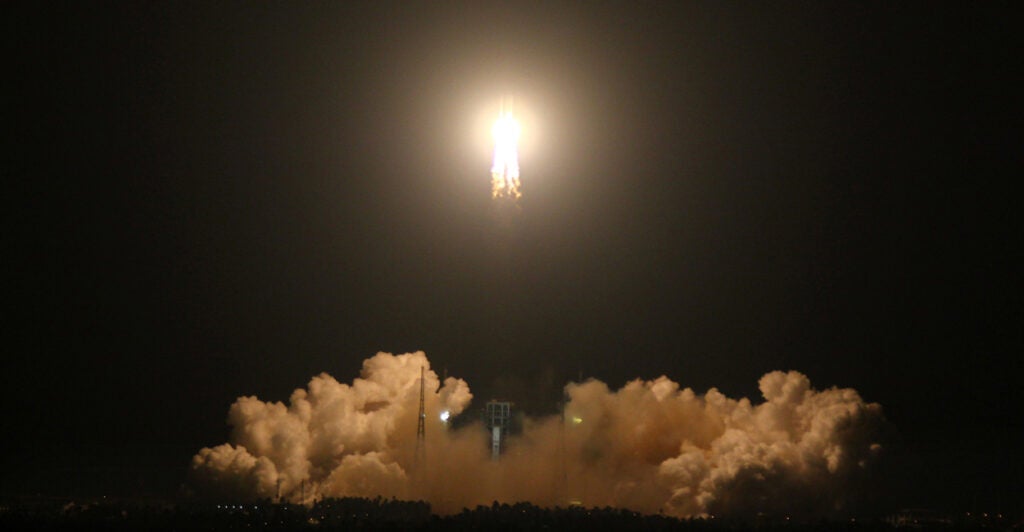It’s a bird! It’s a plane!
No, no—it’s a Chinese fractional orbital bombardment system.
A what?! Yes, a Chinese fractional orbital bombardment system—armed with a hypersonic glide vehicle.
It was revealed in mid-October that China has conducted two tests of this new strategic weapon system during the summer—a development that should seriously concern U.S. defense and allied officials, along with other recent troubling developments surrounding China’s nuclear weapons programs revealed this year.
The new Chinese strategic weapon system was reportedly boosted into low-Earth orbit by a civilian space launch vehicle. The launch vehicle, carrying the hypersonic glide vehicle, then made a partial circumnavigation of the globe. At a specified point, the hypersonic glide vehicle, which serves as the weapon’s warhead, was released from the “mothership” before deorbiting and entering the Earth’s atmosphere en route to its terrestrial target.
Despite missing its intended target by almost 25 miles, the test appeared to be largely a success.
The fractional orbital bombardment system dates back to a Soviet weapons development program during the Cold War, which intended to launch a nuclear warhead into outer space before raining it down on in its enemies. The program was eventually abandoned in favor of submarine-launched ballistic missiles.
Based on this Soviet concept and improved upon with the addition of a cutting-edge hypersonic glide vehicle, the Chinese fractional orbital bombardment system poses a unique threat:
- The fractional orbital bombardment system would have unlimited range, allowing the hypersonic glide vehicle to travel to any number of distant targets, complicating the ability to defend against it.
- Due to its potential flight paths through space and the atmosphere, it could be difficult to acquire and track the weapon system based on physics, geography, and the location of current U.S. strategic radars and other available sensors.
- The glide vehicle warhead is especially dangerous due to its high speed—at least five times the speed of sound—and its maneuverability, effectively reducing the defender’s warning and response time as well as understanding of the ultimate destination of the attack.
- The fractional orbital bombardment system could conceivably be armed with a conventional or nuclear warhead—indeed, perhaps more than one. In addition, the weapon system can utilize just the glide vehicle’s high speed-derived kinetic energy to destroy its objective. These options increase the possible number of high-value targets vulnerable to the weapon system, ranging from strategic command and control complexes to aircraft carriers at sea.
- Lastly, it is also difficult to know if the blastoff of a Chinese boost vehicle is the start of a peaceful, civilian space launch or a belligerent military strike, inserting ambiguity into the defender’s decision-making process. It could also increase the risk of strategic misperception, miscalculation, and mistakes—an unacceptable situation involving nuclear weapons states.
China’s recent fractional orbital bombardment system test raises questions not only about China’s advancing space and missile capabilities, but Beijing’s strategic intentions. If deployed, and in significant numbers, the Chinese fractional orbital bombardment system could insert additional strategic instability into the relationship between Beijing and Washington, rattling already tense ties.
This all comes on top of news the last few months about other disturbing developments in China’s nuclear posture.
Historically, China has relied on a limited strategic nuclear deterrent strategy. Information recently gleaned by civilian researchers from commercial satellites indicates that China is dramatically expanding its land-based nuclear forces. Recent images show construction sites with more than 250 new missile silos across three new intercontinental ballistic missile fields.
As China continues its ICBM silo building efforts, it could potentially match U.S. land-based ICBM capabilities.
As Dean Cheng, a senior research fellow at The Heritage Foundation, notes, “What is very clear is that China is pushing to develop its nuclear capabilities—its strategic intercontinental capabilities—significantly beyond what has been the case for the last four decades … five decades.”
What is also crystal clear is that China’s unprecedented conventional and nuclear military buildup increasingly threatens U.S. vital national interests—and this fractional orbital bombardment system test serves as the latest in a series of wake-up calls for U.S. policymakers about the political and military challenge presented by the People’s Republic of China.
Have an opinion about this article? To sound off, please email letters@DailySignal.com and we’ll consider publishing your edited remarks in our regular “We Hear You” feature. Remember to include the URL or headline of the article plus your name and town and/or state.
